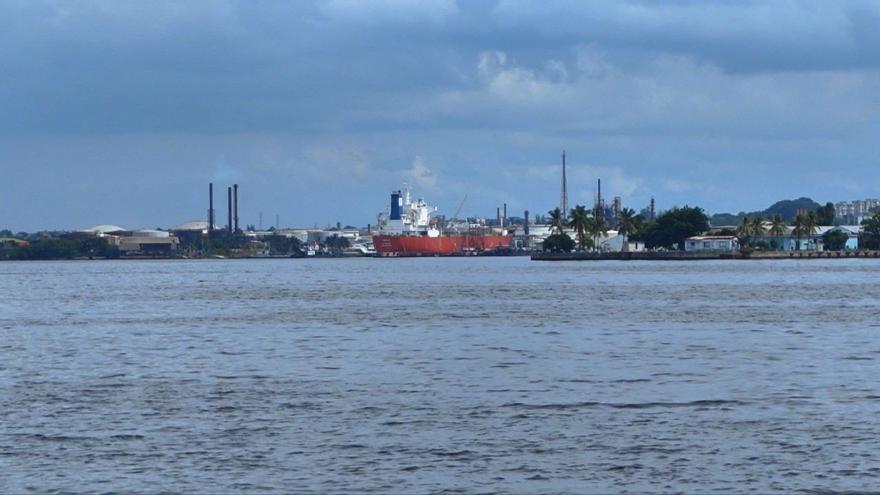
![]() 14ymedio, Havana, 19 October 2023 — On 23rd Avenue, the most fast-paced in Havana, no vehicle was circulating on Thursday morning. In several corners, a crowd of Cubans wait for the arrival of the bus, which doesn’t come. Concerts are even canceled “for energy savings.” Signs of the crisis are everywhere.
14ymedio, Havana, 19 October 2023 — On 23rd Avenue, the most fast-paced in Havana, no vehicle was circulating on Thursday morning. In several corners, a crowd of Cubans wait for the arrival of the bus, which doesn’t come. Concerts are even canceled “for energy savings.” Signs of the crisis are everywhere.
In the port, the Turkish patana [floating power plant] emits a sparse fog, instead of its formidable – and harmful – column of smoke. On the other side of the bay, the refinery is shut down. However, oil tankers continue to arrive on the coasts of the Island, and in a higher number than usual. Of course, they disconnect their radar when entering territorial waters, but maritime tracking applications and the observations of experts do not lie: Cuba continues to receive oil, and in significant quantities, from Venezuela, Mexico, Russia and other allies. What does the regime do with that fuel, and why is the country immersed in the energy debacle? No authority so far has explained this contradiction.
Attentive to the flow of oil tankers, the University of Texas expert Jorge Piñón points out to 14ymedio the coordinates of the ships heading to the Island. “From the Mexican port of Pajaritos – which has been in the spotlight after the controversy about a millionaire credit that the state-owned Pemex negotiated with the U.S. Import and Export Bank – the Delsa left at 11:00 pm this Wednesday, carrying approximately 385,000 barrels of crude oil,” says Piñón. In October alone, the Government of Andrés Manuel López Obrador has sent 800,000 barrels to the Island.
In the port of Matanzas there are four tankers: the Marianna V.V. (flag of Liberia), the Sandino (Cuba), the Aquila (Panama) and the Primula (), while in Mariel there is the Caribbean Alliance, with a Panamanian flag. In Moa, Holguín, the Prairie Tulip, registered in Madeira, is anchored.
In October alone, the Government of Andrés Manuel López Obrador has sent 800,000 barrels to the Island
For its part, the Alicia – with a Cuban flag – left the Venezuelan port of José with an estimated 290,000 barrels of crude oil, while the Lourdes, also Cuban, is waiting to receive a shipment to return to the Island. The Petion ship is anchored, with the same objective, in the port of La Cruz, also in Venezuela, where the Sandino was, one of the ships with a Cuban flag that most often travels to the terminal of José.
With these data, it is inconceivable that the Havana refinery is not processing the 22,000 barrels per day (bpd) that it would under normal conditions, says Piñón. A reporter from 14ymedio found that Ñico López’s torch light was off this Thursday, although it has a tanker anchored next to it, the LPG Emilia, with a Cuban flag.
“Venezuela will have a respite in its oil production thanks to the elimination, for six months, of the sanctions imposed by the United States,” the expert adds. “It is possible that by the end of the year it will reach a production of one million barrels a day. At the moment, its level is 800,000 bpd,” which will guarantee – and even be able to increase – Venezuela’s shipments to Cuba, which are on average 57,000 bpd.
Regarding Venezuela, the expert also estimates that it will take advantage of the increase in production to increase sales and oxygenate its income. The price of a barrel of crude oil currently reaches $90.
Meanwhile, Cubans continue to suffer one of the worst moments of the supply crisis in which the government estimates the causes of the paralysis of the country. In the few gas stations that provide services, a few state vehicles line up to fill their tanks with the meager amount that is given to them. For the others, they have to walk to their work centers or push themselves – as a crowd of passengers did this Thursday – on the red buses of Transmetro, the last lifeline for those who want to go anywhere in Havana.
Translated by Regina Anavy
____________
COLLABORATE WITH OUR WORK: The 14ymedio team is committed to practicing serious journalism that reflects Cuba’s reality in all its depth. Thank you for joining us on this long journey. We invite you to continue supporting us by becoming a member of 14ymedio now. Together we can continue transforming journalism in Cuba.
